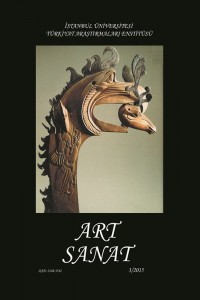Öz
Line, as being one of the major factors in design principles, is used to imitate nature, to express the forms of objects, to illustrate the imaginary things with sketches and to decorate any kind of surface. In miniature paintings, which visualize the text they are involved and make contribution to the explanation of the text, line is used with an attitude of ignoring the details of the form and intending to express the essence of the form. However, line has gained different functions in the single page miniature paintings which started to be produced in the period of Safavids throughout the second half of 16th and 17th centuries, especially in Isfahan. In this style, lines are drawn with brushes in tones using ink; besides, as they are used in various tones of a single colour, forms have gained dimension. One of the most important representative of this calligraphic style, which is used in single page miniature paintings extensively produced in the period of Safavids from the second half of the 16th century, is Rızâ-yi Abbâsî. In this paper, it is intended to disscuss the use of line in miniature painting and its role in producing organic/inorganic forms with the selected miniature paintings of Rızâ-yi Abbâsî
Anahtar Kelimeler
miniature painting line single page miniature paintings Rızâ-yi Abbâsî
Öz
Tasarımın temel unsurlarından olan çizgi, doğayı taklit etmek, nesnelerin formunu ifade etmek, hayal edilen şeyleri taslak halinde canlandırmak ve her türlü yüzeyi süslemek için kullanılmıştır. İçinde yer aldıkları metni görselleştiren ve konuyu açıklamaya katkıda bulunan minyatürlerde ise, çizgi, forma ilişkin ayrıntıları yok eden, formun özünü anlatmaya çalışan bir tavırla kullanılmıştır. Ancak, Safevîler döneminde, 16. yüzyılın ikinci yarısı ile 17. yüzyıl boyunca özellikle İsfahan’da popüler hale gelen tek sayfa minyatürlerde çizginin farklı işlevler kazandığı görülür. Bu üslûpta çizgiler, mürekkep kullanılarak nüanslı bir biçimde fırçayla çekilmiştir; ayrıca, çizgiler, tek rengin çeşitli ton değerleri ile ifade edildiğinden forma boyut kazandırılmıştır. Safevîler döneminde, 16. yüzyılın ikinci yarısından itibaren üretimi yaygınlaşan tek sayfa minyatürlerde görülen bu çizgisel üslûbun en önemli temsilcilerinden biri Rızâ-yi Abbâsî’dir. Bu makalede, minyatürde çizginin kullanılışı ve çizginin canlı/cansız biçimleri oluşturmadaki rolünün, Rızâ-yi Abbâsî minyatürlerinden seçilmiş örneklerle tartışılması amaçlanmıştır.
Anahtar Kelimeler
Ayrıntılar
| Birincil Dil | Türkçe |
|---|---|
| Bölüm | MAKALELER/ARTICLES |
| Yazarlar | |
| Yayımlanma Tarihi | 9 Şubat 2015 |
| Gönderilme Tarihi | 9 Şubat 2015 |
| Yayımlandığı Sayı | Yıl 2015 Sayı: 3 |


